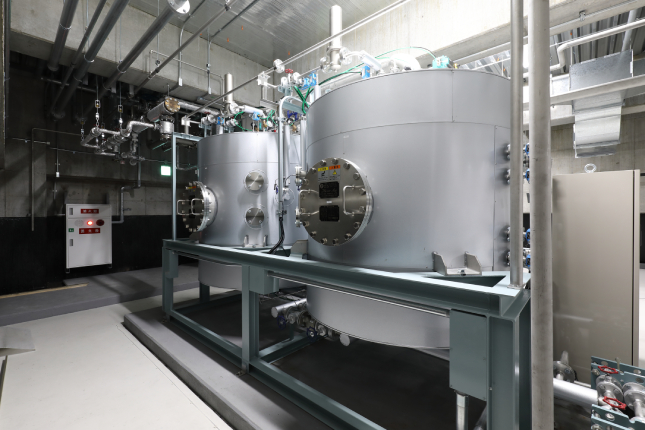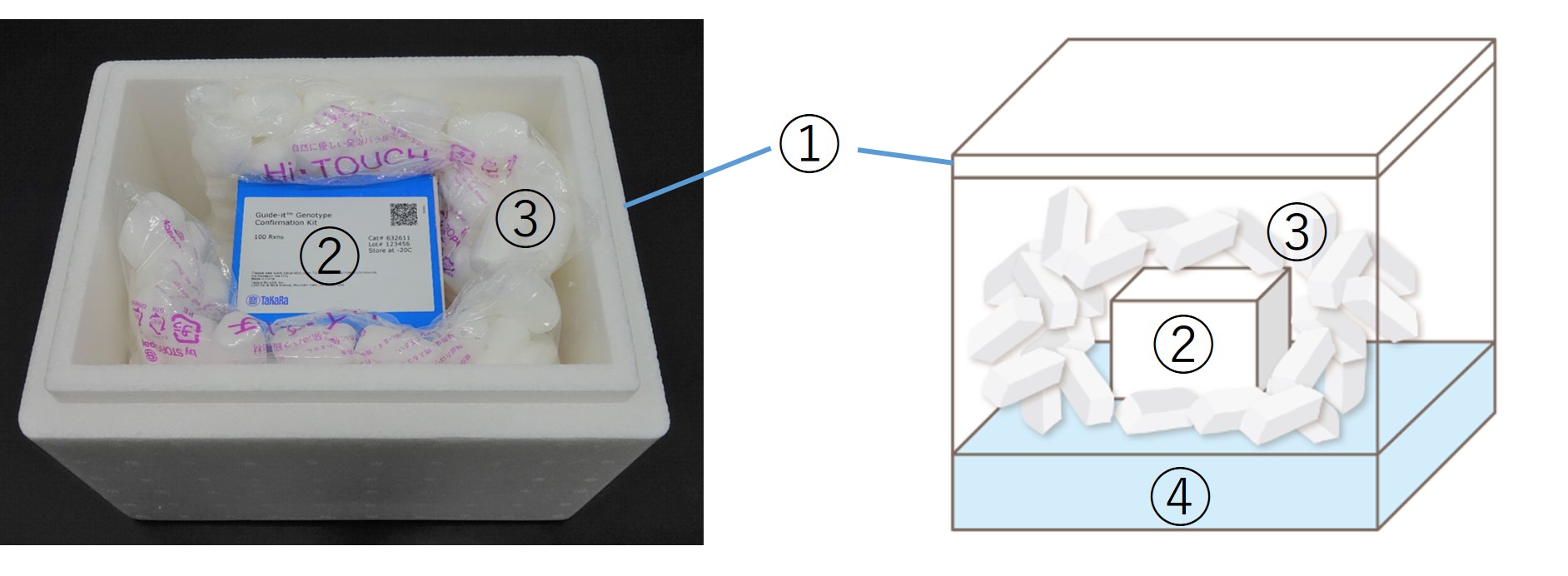We consider the preservation of the global environment and the harmonious conduct of our business activities to be an important topic in the way we manage the company, and to that end we comply with the applicable environmental laws, ordinances, and regulations as we proactively take part in natural conservation activities and work to conserve resources and energy. We are working to reduce the environmental burden generated by all of our processes, ranging from R&D and the procurement of raw materials to production, distribution, sales, and consumption.
Takara Bio Group positions the harmonization of its business activities with global environmental preservation as one of its key challenges, and contributes to building a sustainable society by establishing and continuously improving the environmental management system.
- We comply with laws and regulations related to the environment, in addition to other requirements that we have agreed to.
- In the course of Takara Bio Group’s business activities, we place particular emphasis on the following items.
(1) We strive to prevent environmental pollution.
(2) We strive to promote energy and resource conservation, and try to use sustainable resources.
(3) We strive to reduce greenhouse gas emissions and mitigate climate change.
(4) We support and promote activities related to biodiversity and ecosystem protection and preservation.
(5) We will contribute to the realization of a recycling-oriented society by reducing water consumption, controlling waste generation, and promoting recycling. - We actively disclose information on our environmental initiatives and environmental performance, while striving to communicate with society.
- While using education and awareness programs to convey this Environmental Policy to all members of Takara Bio Group, we also energetically support employees’ participation in social contribution activities.
The main facilities at Takara Bio headquarters account for a large percentage of Takara Bio Group’s CO_{2} emissions and water usage.
At these buildings, we are implementing environmental preservation strategies such as use of construction design that incorporates new building techniques with high environmental performance.
Examples of environmental preservation strategies for Takara Bio headquarters
- Installed cogeneration systems
- Increased heat insulation in exterior walls and windows
- Used high-efficiency transformers
- Enabled visualization of the energy performance through the Building Energy Management System
- Plan to use renewable energy
- Installation of solar panels
- Designed buildings to prevent biohazard risk

Takara Bio Group strives to proactively disclose information to its stakeholders by accurately assessing the risks and opportunities related to climate change, clarifying the impact on its business operations, and clarifying measures to be taken as we work towards the realization of a sustainable society and the sustainable growth of our Group. All assessments are based on scenario analysis in accordance with the Task Force on Climate-related Financial Disclosure (TCFD). Scenario analysis was carried out using a “2ºC or lower scenario,” in which the average global temperature increase is restricted to 2ºC or lower than pre-industrial levels, and a “4ºC scenario,” in which average global temperature is increased by 4ºC. This analysis evaluated the degree of impact on our business operations and the likelihood of those scenarios occurring, examined countermeasures.
We will continue to review risks and opportunities and implement specific measures and reflect them in our medium- to long-term management strategy to enhance our management strategy against climate change.
Takara Bio Group generated 14 thousand t of CO_{2} in fiscal 2025.
Although CO2 emissions decreased due to efficient operation of CGCP building in Japan, CO2 emissions for the entire Group remained at the same level as the previous year due to increased electricity usage in the United States.
On the other hand, our CO2 emissions per unit of revenue (emissions intensity) in fiscal 2025 were 86% of the fiscal 2019 level. We will continue to aim for environmentally conscious business activities.
CO_{2} emission reduction targets
- Reduce emissions per unit of revenue (emissions intensity) to 50% of that of fiscal 2019 by fiscal 2026
In FY2025, the water consumption of the Takara Bio Group was 138 thousand m~{3}, which increased by 21 thousand m~{3} compared to the previous fiscal year.
Primarily due to the expansion of facility operations in Japan and the United States.
Takara Bio, Takara Biotechnology (Dalian) , and Takara Bio USA, which are manufacturing sites, obtain water resources from the water supply system and do not have direct water intake from rivers or sea.

- 拡大
- Kill tank system for wastewater treatment at Takara Bio headquarters
Takara Bio, Takara Biotechnology (Dalian), and Takara Bio USA at manufacturing sites all drain wastewater into sewage systems, and no wastewater is discharged into rivers or oceans.
In biohazard facilities that handle microorganisms, viruses, genetically modified products, etc., a waste liquid sterilization system has been introduced to sterilize contaminated waste water at high temperature and pressure, thereby giving consideration to safety and environment.
Hazardous substances and biologically active substances are also treated as waste to prevent their incorporation into wastewater.
Three major manufacturing sites (Japan, China, and the United States) were assessed using Aqueduct Water Risk Atlas* provided by the World Resources Institute (World Resource Institutions) to identify drought and flood risks (river flooding and sea level rise) required for business continuity at present (FY2025) and in the future (FY2031).
|
Evaluation target |
Present (FY2025) |
Future (FY2031) |
Fiscal 2025 Water Usage |
|---|
|
Takara Bio |
Low to Medium |
Low to Medium |
110 thousand m~{3} |
|
Takara Biotechnology (Dalian) |
Extremely High |
Extremely High |
17.9 thousand m~{3} |
|
Takara Bio USA |
Low to High |
Low to High |
9.9 thousand m~{3} |
We estimate to be low risk as a whole because Takara Bio which accounts for the majority of water use was evaluated as "low to medium".
|
Evaluation target |
Present (FY2025) |
Future (FY2031) |
|---|
|
Takara Bio |
>0 cm |
> 0 cm |
|
Takara Biotechnology (Dalian) |
> 0 cm |
> 0 cm |
|
Takara Bio USA |
0 – 50 cm* |
0 – 50 cm* |
* Facilities in Takara Bio USA are expected to be less vulnerable to damage due to measures to raise their capacity more than 50 cm.
|
Evaluation target |
Present (FY2025) |
Future (FY2031) |
|---|
|
Takara Bio |
- |
- |
|
Takara Biotechnology (Dalian) |
> 0 cm |
> 0 cm |
|
Takara Bio USA |
0 cm |
0 cm |
Estimated low risk of damage caused by rising sea levels at three major manufacturing sites
Takara Bio Group's waste generation in FY2025 was 328 tons, which increased by 9.3 tons compared to the previous fiscal year. In Japan, we reduced some waste by reviewing packaging during transportation and changing disposal methods such as recycling, but due to an increase in the amount of wastewater discharged as industrial waste resulting from an increase in water usage during manufacturing, waste generation increased by approximately 13% compared to FY2024. In Dalian, waste generation decreased by approximately 5% compared to FY2024 due to a decrease in production volume.
Other sites are not drawn in the graph because emissions are low.
Takara Bio Group use paper boxes or PET * film-based pouches containing aluminum for packaging of our main product research reagents. To reduce environmental impact, we are switching to FSC certified material ** and materials using plant-derived oil inks for paper boxes (Fig. 1). In addition, for pouches that contain only one side of aluminum, we are switching to aluminum-less pouches that do not contain aluminum (Fig. 2). For some products, we use double-sided aluminum pouches to maintain product quality.
*Polyethylene terephthalate
** An international system to certify "appropriate forest management" born for the purpose of sustainable forest use and conservation

In transporting research reagents, to avoid the effects of heat, shocks, and vibrations, we package them in polystyrene foam refrigerators along with refrigerants, refrigerants, and cushioning materials to meet product specifications and maintain quality and performance.
From the viewpoint of environmental considerations, we use a refrigerated box for transportation made of recycled polystyrene foam, which is 100% recycled from polystyrene used in foam and used home appliances.
*Transportation through this packaging is adapted to transportation between ①Takara Bio and our distributor in Japan ②Takara Bio and our overseas subsidiaries.
【Example of packing during transportation of refrigerated and frozen reagents】

1. Refrigeration boxes (switching to recycled polystyrene foam)
2. Product
3. Cushioning materials
4. Refrigerants
Theme: Addressing Climate Change Issues
|
Measures |
Targets for FY2026 |
Description |
|
Reduce CO2 emissions per unit of sales by 50% in fiscal 2026 compared to fiscal 2019. |
1) Promote energy conservation activities and use of renewable energy, etc. |
Achieve 50% reduction on a unit basis through expansion of the scope of use of renewable energy and energy-saving activities. |
|
2) To endorse and participate in local and organizational CO2 reduction activities. |
・Respond to the recommendations of the Task Force on Climate-related Financial Disclosure (TCFD). |
|
|
・Support and participate in activities to reduce CO2 in regions (e.g., CO2 Net Zero Movement led by Shiga prefecture). |
||
|
Promoting Information Disclosure on Initiatives for Climate Change. |
Promote disclosures based on TCFD framework. |
・Scope 3 calculation and publication. |
|
・Respond to CDP survey. |
||
|
Improve employees' environmental awareness. |
Promotion of energy and resource conservation activities that can be tackled on an individual basis and on a work-site basis. |
・Implementation of employee environmental education through e-learning, etc. (once a year). |
|
・Promotion of energy and resource conservation activities in daily operations. |
||
|
・Acquire and maintain environmental ISO certification (ISO14001). |
Theme: Environmentally Conscious Product Packages and Packaging
|
Measures |
Targets for FY2026 |
Description |
|
Development of environmentally conscious products. |
1) Promote the conversion of paper packages to forest-certified paper and the use of vegetable oil ink, aiming for 100% by fiscal 2026. |
Achieve targets by fiscal 2026, when gradually switching from the production of new lots. |
|
2) Achieve 100% double-sided aluminum-free packaging for one-sided aluminum-free packaging by FY2026. |
Achieve targets by fiscal 2026, when gradually switching from the production of new lots. |
|
|
3) Change packaging refrigeration box to polystyrene foam (recycled refrigeration box) using recycled materials, aiming for 100% by fiscal 2026. |
Switch to recycled refrigerated boxes (100%). |
|
.jpg)